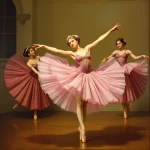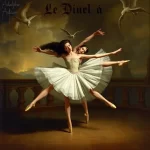Ballet: Mlada (Ludwig Minkus, 1879)

Introduction
Ballet, an art form that combines music, dance, and storytelling, has produced numerous masterpieces over the centuries. One such gem is “Mlada,” a ballet composed by Ludwig Minkus in 1879. This ballet, choreographed by Marius Petipa, premiered on December 14, 1879, at the Imperial Bolshoi Kamenny Theatre in St. Petersburg, Russia. “Mlada” is a fantastical tale that intertwines elements of Slavic mythology and folklore, creating a rich tapestry of music and dance that has captivated audiences for over a century.
Historical Background
Creation and Development
The late 19th century was a period of significant cultural and artistic development in Russia. The country was experiencing a renaissance in the arts, with a particular emphasis on ballet. This era saw the rise of the Imperial Ballet, which became a leading institution in the world of dance. “Mlada” was created in this context, drawing inspiration from Slavic mythology and folklore, which were popular themes in Russian art and literature at the time.
The ballet was a collaborative effort between composer Ludwig Minkus and choreographer Marius Petipa. Minkus, an Austrian composer, was well-known for his work in ballet music, having composed scores for several successful ballets, including “Don Quixote” and “La Bayadère.” Petipa, a French ballet master, was a dominant figure in Russian ballet, renowned for his innovative choreography and ability to tell compelling stories through dance.
Premiere and Reception
“Mlada” premiered on December 14, 1879, at the Imperial Bolshoi Kamenny Theatre in St. Petersburg. The initial reception was mixed, with some critics praising the ballet’s imaginative storyline and Minkus’s evocative score, while others found the plot convoluted and the choreography lacking in coherence. Despite these criticisms, “Mlada” enjoyed several successful performances and was revived multiple times in the following decades.
Synopsis of the Ballet
Act I Summary
The ballet opens with a grand festival in the ancient Slavic city of Retra. The people are celebrating the upcoming wedding of Mlada, a beautiful princess, and Yaromir, a brave warrior. However, the festivities are interrupted by the arrival of the sorcerer Kashchei, who is infatuated with Mlada. Kashchei casts a spell on Mlada, causing her to fall into a deep sleep. Yaromir vows to rescue his beloved and sets off on a perilous journey to find Kashchei’s lair.
Act II Summary
Yaromir’s journey takes him through enchanted forests and mystical realms. Along the way, he encounters various magical creatures and faces numerous challenges. With the help of a wise old hermit and a group of forest spirits, Yaromir eventually discovers the location of Kashchei’s lair. He confronts the sorcerer in a dramatic battle, ultimately breaking the spell and freeing Mlada from her enchanted sleep.
Finale
The ballet concludes with a joyous reunion between Mlada and Yaromir. The people of Retra celebrate their hero’s triumph and the couple’s love. The final scene is a grand wedding ceremony, filled with vibrant dances and jubilant music, symbolizing the victory of good over evil and the power of true love.
Musical Composition
Composer’s Role
Ludwig Minkus played a crucial role in the creation of “Mlada.” His score is characterized by its rich orchestration and memorable melodies, which enhance the ballet’s fantastical atmosphere. Minkus’s music is known for its ability to convey a wide range of emotions, from the joyous celebrations in Retra to the eerie, mystical realms Yaromir traverses. Notable pieces within the score include the “Festival Dance,” the “Forest Spirits’ Dance,” and the climactic “Battle with Kashchei.”
Musical Themes and Motifs
Minkus’s score for “Mlada” features several recurring musical themes and leitmotifs that help to unify the ballet’s narrative. For example, Mlada’s theme is a delicate, lyrical melody that represents her purity and innocence. In contrast, Kashchei’s theme is dark and menacing, reflecting his malevolent nature. These musical motifs are woven throughout the score, enhancing the emotional impact of the story and providing a cohesive musical framework.
Famous Recordings and Performances
Over the years, “Mlada” has been performed by numerous ballet companies around the world. Some of the most iconic recordings of Minkus’s score include those by the Bolshoi Ballet and the Mariinsky Ballet. These recordings capture the grandeur and beauty of Minkus’s music, making them essential listening for ballet enthusiasts.
Choreography and Dance
Choreographer’s Vision
Marius Petipa’s choreography for “Mlada” is a testament to his genius as a ballet master. Petipa’s vision for the ballet was to create a seamless blend of dance and storytelling, using movement to convey the emotions and motivations of the characters. His choreography is characterized by its intricate footwork, graceful port de bras, and dramatic lifts and jumps.
Signature Dance Numbers
“Mlada” features several signature dance numbers that have become iconic in the world of ballet. The “Festival Dance” in Act I is a lively, exuberant number that showcases the technical prowess of the dancers. The “Forest Spirits’ Dance” in Act II is a hauntingly beautiful piece that highlights the ethereal quality of the ballet. The climactic “Battle with Kashchei” is a dramatic, high-energy number that brings the story to its thrilling conclusion.
Notable Interpretations
Over the years, different productions of “Mlada” have interpreted Petipa’s choreography in various ways. Some have stayed true to the original choreography, while others have introduced new elements or modernized the dance sequences. Notable interpretations include those by the Bolshoi Ballet, which is known for its grand, theatrical style, and the Mariinsky Ballet, which emphasizes the lyrical, expressive qualities of the dance.
Characters and Roles
Main Characters
- Mlada: The beautiful princess who falls victim to Kashchei’s spell. She is characterized by her purity and innocence.
- Yaromir: A brave warrior and Mlada’s betrothed. He embarks on a perilous journey to rescue her.
- Kashchei: The malevolent sorcerer who casts a spell on Mlada. He is driven by his infatuation with her.
Supporting Characters
- The Wise Hermit: A mystical figure who helps Yaromir on his journey.
- Forest Spirits: Enchanted beings who assist Yaromir in his quest.
- People of Retra: The citizens who celebrate Mlada and Yaromir’s wedding.
Famous Dancers
Several notable dancers have portrayed the lead roles in “Mlada” over the years. These include Anna Pavlova as Mlada, Vaslav Nijinsky as Yaromir, and Rudolf Nureyev as Kashchei. Their performances have left a lasting impact on the ballet and contributed to its enduring popularity.
Cultural and Artistic Impact
Influence on Ballet and Dance
“Mlada” has had a significant influence on the world of ballet and dance. Its innovative choreography and evocative music have inspired countless choreographers and composers. The ballet’s use of Slavic mythology and folklore has also contributed to the development of a distinct Russian style in ballet.
Cultural Significance
The ballet’s themes of love, bravery, and the triumph of good over evil have resonated with audiences for over a century. “Mlada” has been referenced in various forms of popular culture, including literature, film, and theater. Its rich, fantastical narrative continues to captivate and inspire new generations of artists and audiences.
Legacy and Revivals
“Mlada” has been revived numerous times since its premiere, with each new production bringing fresh interpretations and perspectives. Major revivals include those by the Bolshoi Ballet and the Mariinsky Ballet, both of which have contributed to the ballet’s enduring legacy. Today, “Mlada” continues to be performed and celebrated around the world, a testament to its timeless appeal.
Iconic Productions
Historic Productions
Some of the most famous historical productions of “Mlada” include the original 1879 premiere at the Imperial Bolshoi Kamenny Theatre and subsequent revivals by the Bolshoi Ballet and the Mariinsky Ballet. These productions featured renowned dancers such as Anna Pavlova and Vaslav Nijinsky, as well as innovative set and costume designs that brought the fantastical world of “Mlada” to life.
Contemporary Productions
Recent productions of “Mlada” have introduced new elements and modernized aspects of the ballet while staying true to its original spirit. Contemporary choreographers have experimented with different styles and interpretations, resulting in fresh, dynamic performances that continue to captivate audiences. Notable contemporary productions include those by the Royal Ballet and the American Ballet Theatre.
Production Design
The set, costume, and lighting design in various productions of “Mlada” have played a crucial role in creating the ballet’s magical atmosphere. Historic productions often featured elaborate, opulent sets and costumes that reflected the grandeur of the Imperial Russian court. Contemporary productions have experimented with minimalist and abstract designs, using innovative lighting techniques to enhance the ballet’s mystical elements.
Critical Reception and Reviews
Initial Critical Response
The initial critical response to “Mlada” was mixed. While some critics praised the ballet’s imaginative storyline and Minkus’s evocative score, others found the plot convoluted and the choreography lacking in coherence. Despite these criticisms, “Mlada” enjoyed several successful performances and was revived multiple times in the following decades.
Modern Reviews
Contemporary critics and audiences have generally been more favorable in their assessments of “Mlada.” Many appreciate the ballet’s rich, fantastical narrative and the emotional depth of Minkus’s music. Modern productions have been praised for their innovative choreography and dynamic performances, contributing to the ballet’s enduring popularity.
Fun Facts and Trivia
Behind-the-Scenes Stories
One interesting anecdote from the production of “Mlada” involves the original set design. The elaborate sets for the premiere were so large and complex that they had to be transported to the theater in multiple pieces and assembled on-site. This logistical challenge added to the excitement and anticipation surrounding the ballet’s debut.
Notable Performers
Several famous dancers have been associated with “Mlada” over the years. Anna Pavlova, one of the most celebrated ballerinas of all time, performed the role of Mlada in a 1908 revival. Vaslav Nijinsky, known for his incredible athleticism and expressive performances, portrayed Yaromir in a 1910 production. Rudolf Nureyev, another legendary dancer, took on the role of Kashchei in a 1965 revival.
Trivia
- “Mlada” is one of the few ballets that incorporates elements of Slavic mythology and folklore, making it a unique addition to the classical ballet repertoire.
- The ballet’s original score by Ludwig Minkus was lost for many years but was eventually reconstructed from surviving manuscripts and recordings.
- “Mlada” has been adapted into various forms of media, including a 1922 silent film and a 1980s animated television series.
Conclusion
Summary of the Ballet’s Importance
“Mlada” is a significant work in the world of ballet, combining rich storytelling, evocative music, and innovative choreography. Its themes of love, bravery, and the triumph of good over evil have resonated with audiences for over a century, making it a timeless classic.
Final Thoughts
Reflecting on “Mlada,” it is clear that this ballet has left an indelible mark on the world of dance. Its unique blend of Slavic mythology and classical ballet elements continues to captivate and inspire new generations of artists and audiences. Whether you are a seasoned ballet enthusiast or a newcomer to the art form, “Mlada” is a must-see performance that showcases the beauty and power of ballet.
FAQ
What is the central theme of this ballet?
The central theme of “Mlada” is the triumph of love and bravery over evil, as exemplified by Yaromir’s quest to rescue Mlada from Kashchei’s spell.
Who are the main characters in this ballet?
The main characters in “Mlada” are Mlada, a beautiful princess; Yaromir, a brave warrior; and Kashchei, a malevolent sorcerer.
What is the most famous dance number in this ballet?
One of the most famous dance numbers in “Mlada” is the “Festival Dance” in Act I, which showcases the technical prowess and exuberance of the dancers.
How long does a typical performance of this ballet last?
A typical performance of “Mlada” lasts approximately two hours, including intermissions.
Are there any modern adaptations of this ballet?
Yes, “Mlada” has been adapted into various forms of media, including a 1922 silent film and a 1980s animated television series. Contemporary ballet companies also continue to perform and reinterpret the ballet.
Why is this ballet considered important in the history of dance?
“Mlada” is considered important in the history of dance due to its innovative choreography, evocative music, and unique blend of Slavic mythology and classical ballet elements. It has influenced numerous choreographers and composers and continues to be celebrated and performed around the world.





